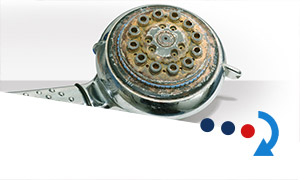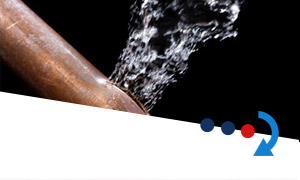Lexicon drinking water
Bacteria : are very small mono-celled micro-organisms which are often rod-shaped. In Greek, “bakteria” means bar, rod. A number of them are, among other things, the cause of many contagious diseases. Many other bacteria are harmless or even useful to man.
Calcium : Calcium : (chemical symbol Ca) Calcium is a widely-occurring metal in nature. In calcareous rocks, it can be found as calcium carbonate. Calcium is the main element to determine the hardness of water. The human organism needs about 700 to 900 mg per day. The maximum allowable concentration in drinking water is 270 mg/l.
Chlorine : (chemical symbol Cl) is a chemical element which occurs in nature in the form of salts. In its free form, it is a green-yellow gas. Hence its name (chloros is the Greek word for green). Even in low concentrations in water, it is a highly effective bactericidal. The maximum allowable concentration in drinking water is 0.25 mg/l.
Corrosion : is an interaction between a material (mostly metal) and its environment (e.g. water), the material, mostly through oxidation, being entirely or partially converted into inferior matter, as a result of which its original characteristics deteriorate (e.g. loss of mechanical strength). The best-known form is rust.
Filtration : is a technique in which particles, present in a liquid, are stopped by a porous (pervious) body.
Fluorine : (chemical symbol F) occurs in nature in a bound form (in minerals and organic molecules). Fluorine occurs in almost every type of food. Via food, we daily take in 0.5 to 2 mg. An overdose of fluorine can lead to fluorosis. The maximum allowable concentration in drinking water is 1500 µg /l.
Phosphates : (chemical formula : PO4) are salts derived from phosphoric acid (H3PO4). Phosphorus in the form of phosphate is essential for plants and animals. For surface water, phosphate is of special importance because high phosphate concentrations cause more algae growth. Phosphate salts are also used for the treatment of drinking water as a corrosion inhibitor.
Hardness levels : The hardness of the water is determined by the calcium and magnesium level of the water. It is expressed in three ways :
- German degree (1° D), equals 10 mg of calcium oxide (CaO). This, in turn, equals 7.14 mg of calcium or 4.28 mg of magnesium per litre of water.
- French degree (1° F) equals 10 mg of calcium carbonate (CaCO3) which equals 4.0 mg of calcium or 2.4 mg of magnesium per litre of water.
- mmol : 1 mmol equals 40 mg of calcium or 24 mg of magnesium per litre of water, which equals 10 French degrees.
Iron : (chemical symbol Fe) Very widespread metal. Food provides about 15 to 25 mg of iron per day. The maximum allowable concentration in drinking water is 0.2 mg/l.
Calcification : water containing calcium and magnesium salts can in certain circumstances cause formation of lime or “boiler scale” on tube walls, resistors and heating elements. Calcification is accelerated in the event of aeration of the water and increase of the temperature. Apart from the hardness of the water, the carbon dioxide and biocarbonate concentrations in the water, the alkalinity are also of importance.
Carbon dioxide (chemical symbol CO2). Carbon dioxide is an odourless gas which occurs in nature (cf. greenhouse effect) and is also present in the breath of humans and animals. Groundwater is generally rich in carbon dioxide. It is added to sparkling mineral water. This gas is responsible for corrosion and erosion of materials that come in contact with drinking water.
Legionella : is a bacterium which causes a type of bronchitis, especially in weakened persons. The word is derived from the English word “Legionnaire” (veteran), because the disease spread massively for the first time at a veterans’ reunion in the USA. It is therefore also sometimes called “veterans’ disease”.
Lead : (chemical symbol Pb). This metal was often used in the industry. Well after the Second World War, this metal was used for domestic connections and in-house installations for drinking water. The maximum allowable concentration in drinking water is 0.05 mg/l. The new European guideline will lower this concentration to 0.01 mg/l (weekly average).
Magnesium: (chemical symbol Mg). This is one of the most widespread metals in nature. Magnesium is an element which determines the hardness of water. The human organism needs about 420 mg per day. The maximum allowable concentration in drinking water is 50 mg/l.
Microgram : 1 microgram (1µg) equals 1 thousandth of a milligram (mg).
Milligram : 1 milligram (1mg) equals 1 thousandth of a gram (g).
Sodium : (chemical symbol Na) plays an important role in food and in the industry in the form of sodium chloride (common salt). Sodium is an essential element of water. Its concentration in water amounts to a few mg up to 500 mg per litre and even more. An adult needs about 2,000 mg per day. Food already provides about 3,000 to 5,000 mg per day. It is therefore unnecessary to add salt to our food. The law concerning water meant for human consumption sets a limit of 150 milligram of sodium per litre of water at the point of delivery. At the tap, a value of 200 mg/l should be taken into account as an indicator parameter.
Nitrate : (chemical formula NO3-) is a chemical compound, namely a salt derived from nitric acid (HNO3). Nitrates are used in agriculture as fertilizer and are all well soluble in water. As a result, this compound poses a threat to the groundwater quality, mainly in shallow water reclamation areas. The maximum allowable concentration in drinking water is 50 mg/l (expressed in NO3-).
Nitrite : (chemical formula NO2-) is a chemical compound, namely a salt derived from nitrous acid (HNO2). It occurs in water as a result of bacterial oxidation of ammonium; this intermediate product of oxidized ammonium is rapidly further oxidized into nitrate. In the gastro-intestinal system, especially that of young babies, nitrate is converted into nitrite. The maximum allowable concentration in drinking water is 0.1 mg/l (expressed in NO2-).
Oxidation : Is a chemical process in which oxygen reacts with other chemicals. Combustion of charcoal is an example of oxidation : this requires oxygen as a reactant and leads to the formation of reaction products such as carbon dioxide. In oxygen-containing water, oxygen also acts as an oxidant. Examples of this include rusting iron, oxidation of copper, etc.
Polyphosphates : are made up of various phosphate molecules, which in turn are salts from phosphoric acid. Their structure allows them to form soluble compounds (named complexes) with calcium or magnesium. The maximum allowable concentration in drinking water is 5 mg/l (expressed in P2O5).
Rust : is a compound of oxygen with iron. Rust is created by slow combustion (oxidation) of iron in a humid environment.
Silicates : are salts of silicon, the chemical element (Si), which occurs most in the earth’s crust. The best-known silicon-containing materials in nature are quartz sand and clay.
Nitrogen : (chemical symbol N from “Nitrogen”). Our atmosphere (the air) is composed of 1/5 oxygen gas (O2) and 4/5 nitrogen gas (N2). Both gases are soluble in water. The solubility depends on physical factors such as pressure and temperature. Nitrogen is an element of prime importance in the composition of living matter, which explains the use of nitrogen-containing fertilizers in agriculture.
Virus : is derived from Latin and means poison, contagium. The word refers to small organisms, which can only develop in foreign living cells.
Water hammer : When the flow of water (or another liquid) in a pipe is suddenly slowed or interrupted, this can lead to pressure surges. Water hammer can be caused by turning off a stop valve too fast or by the presence of air in the pipes. These sudden pressure surges may cause serious damage to pipes and devices.
Salts : are the result of a reaction of an acid with a base. In chemistry, numerous salts are known. In salts, a distinction is made between well soluble and less soluble salts. Common salt is an example of well soluble salts. In water heaters, boiler scale (calcium carbonate) is formed, which is an example of an insoluble salt.
Acidity : or pH-value of a solution varies between 1 and 14. In neutral water, the pH-value or acidity equals 7. If the pH-value of a solution lies between 7 and 14, the solution is basic. If the pH-value lies between 1 and 7, the solution is acid. The normal value for the pH of drinking water varies between 6.5 and 9.2.
Save water?
Start with regularly checking for leaks. Write down the water meter’s level at the beginning of a period during which no water will be consumed and check at the end.
Lexicon Drinking water
Everything you ever wanted to know about drinking water and the treatment of your wastewater.




